
by Marelise da Silva | Sep 18, 2019 | Social Media Optimization
Building a strong social media presence is hard work and it takes time. Yet even the most well-established presence can be tarnished in a second by a single post. If you are posting, have posted or are planning to post any of the following five types of social media content, you should stop yourself straight away.
1. Hard-Sell Promotion
Yes, you’re trying to promote yourself or your product… But, your social media channels are not the right platforms for heavy selling. Keep it fun, personal and conversational while gently raising awareness of what you do. Your friends and followers will not appreciate attempts to shove your services down their throats.
2. Viral Content That People Have Seen Elsewhere
Your social media schedule tells you need to post now and you’re low on content. So, you grab a viral piece of topicality, that somewhat relates to your goals and strategy, and quickly post it. Big mistake. You can rest assured that your audience has already seen it and any reputation you have built for good, original content has just taken a serious knock.
3. Negative Content
It’s never a good time to criticise your competitors or say something that might make your clients and prospective customers feel bad. Don’t draw attention to your competitors at all. And, always make your clients feel good. Simple.
4. Off-Brand” Posts
If you have properly devised your social media strategy in line with your overall marketing aims, you should be posting content that is consistent with your brand’s look, feel and voice. Avoid posting anything that doesn’t fit these. It will strike your audience’s ear like a musician playing a bad note and will be a definite black mark against your name.
5. Copied and Pasted Content Across All Platforms
It’s tempting to try and kill several birds with one stone by just posting the same message across all your social media accounts. This is definitely a mistake, however. Twitter, Facebook and Instagram all facilitate different kinds of messages and communication styles. You need to bear this in mind and tailor your message to each one.
WSI OMS is an established expert in social media marketing. Contact us for help to plan your social media strategy.

by Marianna Muscat | Apr 23, 2019 | Social Media Optimization
YouTube is a vehicle, not a destination. Many people, from online influencers to business owners, have successfully used YouTube to build their personal brands over the years. If you want to build your online presence and create more opportunities for yourself, then YouTube is a great tool to help you to achieve this goal.
Social media websites such as Instagram, Facebook and Twitter are also good tools for building your brand, but the problem with these sites is that the content doesn’t always live on. Content that gets posted on these sites is only there for a moment, whereas your content on YouTube lives on in the search results. Think of your YouTube channel as your own personal Netflix. It is a body of work, not a social media feed that keeps going and going. Your content on YouTube can continue to bring opportunities to you a week, month or year after it has been posted. Here are some practical ways to build your presence on YouTube:
After you have created your YouTube channel and customised the page, you need to set a schedule to start creating content. This is where you should focus on the adage “show, don’t tell.” With your website, you are limited to static web pages, but you can film everything from product demonstrations to your workshops and elevator pitch on your YouTube channel.
Being able to show the process of your work and communicate your personality in a different way is what makes YouTube marketing invaluable. It is one of the most effective ways to communicate.
Do you want leads? Do you need to boost brand awareness? Do you want 1 000 new subscribers each month? Think about your goals for this platform, so that you consistently work towards achieving these goals.
- Interact With Your Community
YouTube marketing is not a one-way channel. Keep an eye on the comment section of your videos and interact with people who engage with you. You can also use your YouTube channel to crowdsource ideas.
Need help with your social media marketing? Then contact WSI OMS today.

by Francois Muscat | Jun 20, 2018 | Facebook, Social Media Marketing, Social Media Optimization
It’s one thing to have engagement on your Facebook page, but it can be a whole different ballgame to get people to click away from your page and visit your website. Here are a few things that you can do to drive traffic to your website from Facebook:
- Create a post
Sometimes it is helpful to experiment with different types of posts. You may find, for example, that people are more likely to click on your post if you have shared something to Facebook via a link share (as opposed to adding a link within a status update). You can check this data by using a link shortener such as bit.ly that will provide you with link activity information.
Another thing to experiment with is the different times of posting. See how your engagement varies if you post a link early in the day versus later in the afternoon.
- Promote to fans
Once you have created a post, you need to promote your post to people who have liked your page. When you promote your post to fans, you will be able to ensure that around 30% of your fans see the post within their news feeds (as opposed to only 10 – 15% of people).
- Promote to non-fans
You can look into strategically promoting your posts to people who haven’t already liked your Facebook page. To make sure you are targeting relevant people, you can specify precise interests or other relevant information when choosing who should see the post. Custom audiences are also a great way to ensure the right people are seeing your posts. You can create a custom audience of your email subscribers, for example, for this.
Need help with your social media marketing strategy? Then http://www.wsioms.co.za/contact-us contact WSI OMS today.

by Marelise da Silva | Dec 28, 2017 | Social Media Optimization
When you first start making the most of the online world when it comes to promoting your business, you will be told that you need both a solid digital marketing strategy, as well as a well-structured plan of action for social media marketing. The question is, what is the difference between the two? We investigate below.
-
What is Digital Marketing?
Digital marketing is all about using the digital tools available (i.e. PPC advertising, SEO, content marketing, email marketing etc.) to promote your business online and to reach as many potential customers as possible.
-
What is Social Media Marketing?
Social media marketing is a form of digital marketing that takes place on various social media platforms, such as Facebook, Instagram, LinkedIn and Twitter. It also involves communicating and engaging directly with your company’s followers.
-
How Do They Work Together?
The success of both relies heavily on a knowledge of the wants, needs and expectations of your target market. Ultimately, social media marketing helps to support your digital marketing strategy. It allows you a direct line of access to your audience and makes it possible for you to gain valuable insight in terms of what is working and what needs to change regarding your approach. In short, a company’s online reputation depends on both digital marketing and social media marketing coming together.
Want to know more? Perhaps you would like an expert’s opinion regarding your online marketing efforts? If so, it’s time to contact WSI OMS. As a leading digital marketing agency, we will provide you with a range of services that are sure to help guide your business to the top!

by Marianna Muscat | Aug 23, 2016 | Content Marketing, Social Media Optimization
It’s not a new term, but one which some people may have missed – the Rule of Thirds. What this refers to is dividing your social media content into thirds and using it in different ways, to increase and maintain an engaged audience. These are:
- 1/3 of your social content promotes your business, converts readers and generates profit.
- 1/3 of your social content should surface and share ideas and stories from industry thought leaders or like-minded businesses.
- 1/3 of your social content should build your personal brand and be based on your personal interactions.
While sharing your own branded content to promote your business is easy enough, the other two thirds may be a bit harder. Sharing another business’ content is equally important to your own, showing your audience you’re aware of the competition, you know your industry inside out and you’re willing to collaborate. Sharing another business’ content also shows that you are confident in your own brand and it helps to broaden your exposure to the online community.
To find shareable content from other businesses, you need to identify industry influencers and your competition. You can follow industry hashtags and keywords, which has the added bonus of giving your more material for your own content. Set up streams for easy listening and retweet relevant material to make your Twitter feed look more dynamic. Without this important element of sharing in your social media, your business will look like the person who only wants to speak about himself.
Building your personal brand can be done in two ways – you can use your own channels, like Facebook, Pinterest and Instagram, to share engaging content; and your business’ social media channels to show a more personable side of the business – you could share customer’s stories, like their comments and share a bit about your team in a social setting. You should empower and encourage your team to contribute to blogs, comment on customer feedback. If you receive a particularly good piece of feedback from a customer or supplier, invite them to guest blog.
Finding the right balance can be hard, but it’s worth it. If you’d like assistance in achieving the Rule of Thirds in your social media strategy, contact us. Our social media marketers know all the secrets and can help you build and maintain an online community.

by Francois Muscat | Jul 20, 2016 | Social Media Optimization, Social Selling
Social selling – a big buzzword of 2015 – is the process of developing relationships as part of the sales process. Taking place mainly on social networks like Facebook, Twitter, Pinterest and LinkedIn, it’s a technique largely used in B2B selling. The difference between social selling and traditional selling techniques of days gone by, is that social selling aims to cultivate one-on-one relationships, rather than broadcasting a message to many.
Social selling is gaining more and more traction, largely due to five trends:
- Changing buyer behaviours
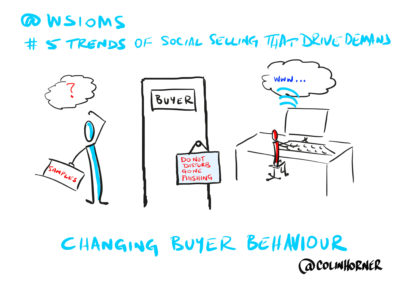
Buyers have more control than they ever did before, now turning online for more product information, rather than relying on salespeople. This has extended the period between initial interest and the purchase. Many companies are using social media platforms to influence their buying decisions, from reviews to personal opinions.
- Evolving marketing departments
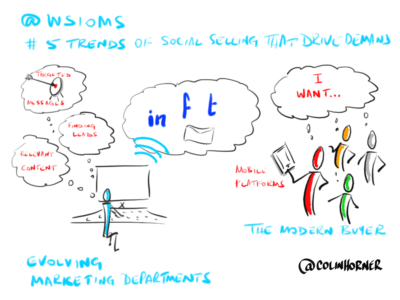
Marketing teams have had to adapt to the modern buyer, producing relevant content across digital channels – social, email and mobile. Targeted messages are reaching buyers through automation. Salespeople are having to change their game, working at new ways of manipulating social networks for lead generation, as well as nurturing their existing customers.
- The rise of sales enablement
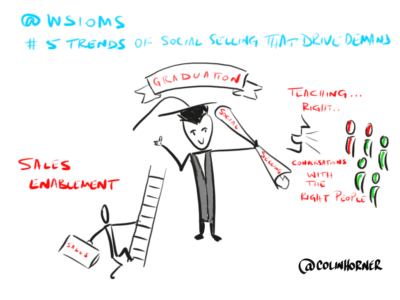
Sales enablement staff play a crucial role in educating sales reps to have the right conversations with the right people at the right time. Social selling is a skill that must be learned, so having support resources on hand makes social selling less frightening for sales reps and leaders.
- The need for personalisation
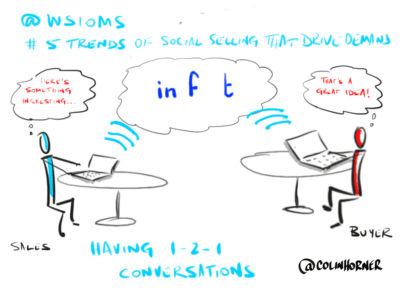
Sales reps still need to have one-on-one conversations with buyers and social media is ideal for this. By empowering your sales reps on social media, you offer your customers a human-to-human interaction
- Social platforms have become more user-friendly
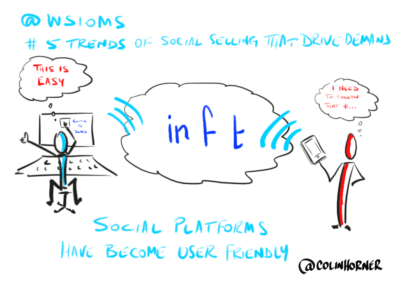
Until recently, many social selling platforms were complicated, feature-laden social media management tools that were baffling to most. Today, with simpler yet more consumer-centric options, the social seller is able to master the platform fairly quickly.
Social selling has become an integral part of enterprise sales organisation, with business owners realising that this is the future of selling. If you would like to find out more about social selling, contact us.












